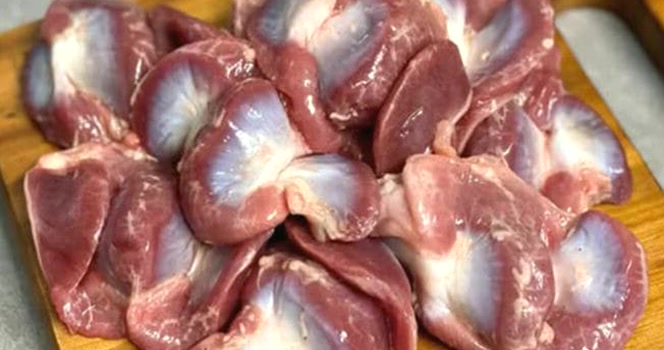Chicken gizzards might just be the best-kept secret in the food world.
They’re packed with nutrients, insanely affordable, and ridiculously delicious when prepared right. Yet, so many people ignore them just because they fall under the category of “offal”—a term that unfairly makes them sound unappetizing.
If you’ve never given chicken gizzards a shot, you’re missing out on a powerhouse of protein, vitamins, and minerals that can fuel your body without draining your wallet. Let’s dive into why these underrated gems deserve a permanent spot on your plate.
What Even Is a Chicken Gizzard?
Think of the gizzard as the bird’s natural food processor. Birds don’t have teeth, so instead of chewing, their food moves through the crop (a storage pouch) and then into the gizzard, which acts as a super-strong grinder. Thanks to its thick, muscular walls, it pulverizes seeds and grains, making digestion possible.
The result? A lean, flavorful cut of meat with a dense, chewy texture that becomes incredibly tender when cooked the right way.
Why You Should Eat Chicken Gizzards
1. They’re a Protein Powerhouse
Gizzards are loaded with protein—around 20 grams per 3-ounce serving. Whether you’re a gym rat, an athlete, or just trying to build muscle, they’re a fantastic (and cheap!) protein source.
2. Low in Fat, High in Gains
Unlike some other meats, chicken gizzards are super lean, containing less than 3 grams of fat per serving. This makes them a great choice for anyone watching their calorie intake or aiming for a heart-healthy diet.
3. Packed With Essential Vitamins
- Vitamin B12: Essential for nerve function, red blood cell production, and energy levels.
- Niacin: Boosts metabolism, improves skin health, and supports heart health.
- Choline: Crucial for brain health, liver function, and fetal development during pregnancy.
4. Rich in Iron and Minerals
Iron helps prevent anemia and keeps your energy levels up, while selenium and zinc support your immune system and promote healing. If you’re prone to iron deficiency, gizzards can be a game-changer. Gizzards are also a good source of vitamin C, riboflavin, magnesium, copper and manganese.
5. They’re Crazy Cheap
In a world where meat prices are skyrocketing, chicken gizzards remain one of the most budget-friendly protein sources out there. You can often grab a pound for just a few bucks—making them perfect for families, meal preppers, or anyone looking to save money without sacrificing nutrition.
How to Cook Chicken Gizzards (Without Screwing Them Up)
If you’ve never cooked gizzards before, don’t worry. They’re incredibly versatile, and with the right technique, they turn out chef’s kiss delicious.
1. Boil & Stew for Ultimate Tenderness
Gizzards can be tough, but a slow simmer makes them melt-in-your-mouth tender. Boil them for 30-45 minutes with salt, garlic, and spices, then toss them into soups or stews.
2. Deep-Fry for Crispy Goodness
Want something crunchy? Coat gizzards in seasoned flour, fry until golden brown, and dip them in your favorite sauce. They’re basically the ultimate bar snack.
3. Sauté or Stir-Fry for Quick & Easy Flavor
Slice boiled gizzards and toss them in a hot pan with onions, bell peppers, and spices. The result? A high-protein stir-fry that pairs perfectly with rice or noodles.
4. Grill for Smoky Perfection
Marinate gizzards in soy sauce, garlic, and vinegar, then grill them to smoky, charred perfection. Serve with grilled veggies or a dipping sauce.
5. Slow-Cook for Fall-Apart Tenderness
Throw gizzards in a slow cooker with broth, herbs, and veggies, and let them do their thing for a few hours. The longer they cook, the softer they get.
Must-Try Gizzard Recipes
- Gizzard Adobo: A Filipino favorite—simmered in soy sauce, vinegar, and garlic for a tangy, savory dish.
- Spicy Stir-Fried Gizzards: Tossed in chili sauce with veggies for a kick of heat.
- Gizzard Soup: A hearty, comforting broth loaded with tender gizzards and root vegetables.
- Gizzard Tacos: Crispy, spicy gizzards stuffed in warm tortillas with salsa and lime.
- Gizzard Salad: A protein-packed salad with greens, tomatoes, and a zesty dressing.
The Only Drawback? The Texture (But You Can Fix That!)
Not gonna lie—if you’re new to gizzards, the chewy texture might take some getting used to. But if you cook them properly (boil first, then crisp up or stew), they become tender and juicy.
Also, like with anything, moderation is key. Gizzards contain cholesterol, so if you’re on a strict low-cholesterol diet, you might want to enjoy them in moderation.
Are There Any Risks?
Few studies have been conducted on gizzards in particular. As Medical News Today notes, some organ meats are high in saturated fat. If your cholesterol levels are above normal, enjoy these foods in moderation. Gizzards, though, have less than one gram of saturated fat per serving, so they’re unlikely to affect blood cholesterol levels or cardiovascular health.
Researchers also point out that organ meats contain purines and should be avoided by people with gout. These organic compounds raise uric acid levels and may trigger gout attacks.
If you think you’re eating too much chicken, including gizzards, consider switching to organic brands. Farmers often use antibiotics to prevent disease in chickens. A diet rich in poultry may promote the development of drug-resistant bacteria, which claim more than 23,000 lives in the United States each year, according to The Guardian. The only way to mitigate these risks is to go organic.
Bottom Line: Give Gizzards a Chance!
If you’re looking for a high-protein, nutrient-dense, and super affordable meat option, organic chicken gizzards are the way to go. They’re easy to cook, incredibly versatile, and way too underrated.
Next time you’re at the grocery store, pick up a pack and try one of these cooking methods. You might just discover your new favorite budget-friendly protein!
Would you try chicken gizzards? Let us know in the comments!

